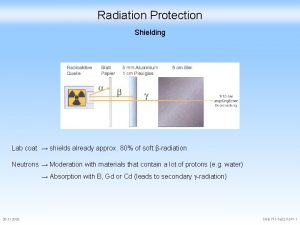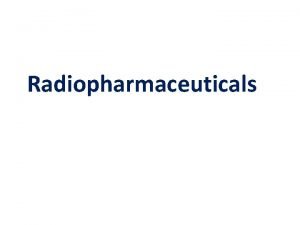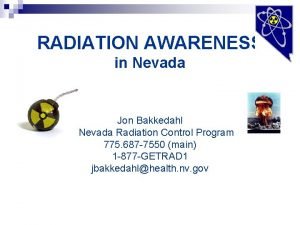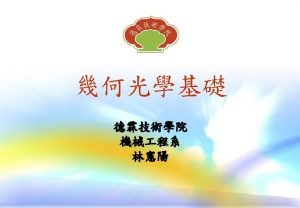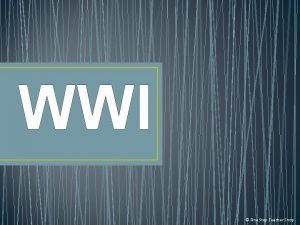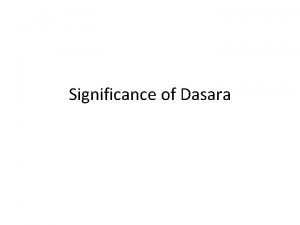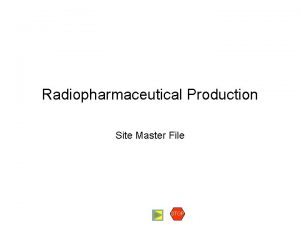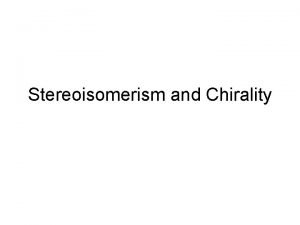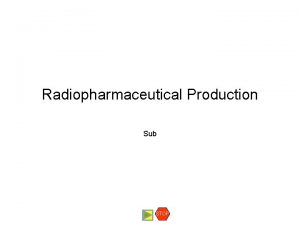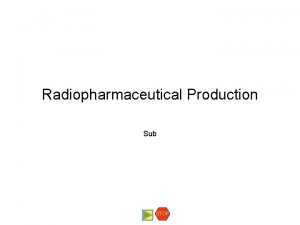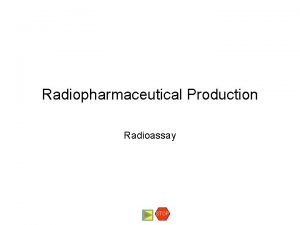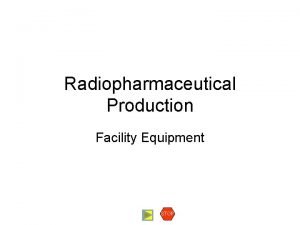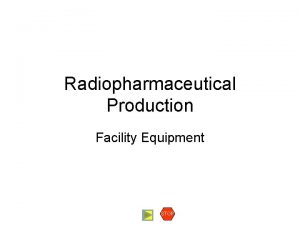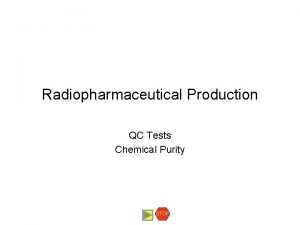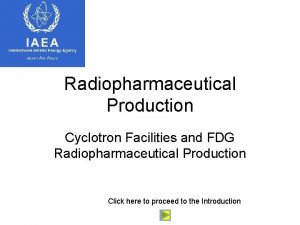Radiopharmaceutical Production Radiochemical identity and purity STOP Radiochemical










- Slides: 10

Radiopharmaceutical Production Radiochemical identity and purity STOP

Radiochemical identity and purity Radiopharmaceutical Production QC Testing Radiochemical Identity and Purity • Contents Acceptance Criteria Procedure Discussion Example • STOP This test is usually done by radio thin layer chromatography (TLC). This method has the advantage of ensuring that all the activity is on the plate and therefore an impurity that might stick to an HPLC column will not be missed. It is also an east test to perform as long as care is taken in the application of the radioactivity spot and an authentic sample is cospotted along side the test sample Contents • Acceptance Criteria • Procedure • Discussion • Example

Acceptance Criteria Radiopharmaceutical Production QC Testing Radiochemical Identity and Purity Contents Acceptance Criteria: Radiochemical Identity: In a TLC chromatogram of FDG test sample, the retention factor (Rf) of the principle peak corresponds with that of the reference standard of non-radioactive FDG (Rf~ 0. 4). The test should be completed on every batch prior to release of product. Procedure Radiochemical Purity: Not less than 95% of radioactivity in the test chromatogram is found at the spot that corresponds with the reference standard of FDG. The test should be completed prior to release of product. Discussion Example The USP monograph for FDG states 90% radiochemical purity is acceptable while the EU and IP monographs require 95%. STOP

Procedure Radiopharmaceutical Production QC Testing Radiochemical Identity and Purity Contents Acceptance Criteria Procedure Discussion Example Procedure: (read and see an example) Prepare a test sample having number of counts suitable for the radioactivity detector. On a silica gel TLC plate (10 cm x 2 cm), apply about 5µl (or a suitable volume) of test sample side by side with a cold FDG standard sample. Dry the spots in a stream of air (no heat should be applied for drying). Meanwhile add sufficient amount of acetonitrile: water mixture (95: 5 v/v) as the mobile phase to the TLC chamber, allow few minutes for the chamber to become saturated with the mobile phase. Insert the TLC plate in the chamber; the solvent level must be below the test spot. Allow the solvent front to migrate to the top of the TLC plate. Remove the TLC plate and mark the solvent front. Measure the radioactivity counts on the plate using TLC radioactivity scanner (or apply cut and count method). Calculate the Rf and the RC purity from the measured counts. The cold FDG can be visualized by spraying the developed TLC plate with 1% P-anisidine reagent P-anisidine reference: [Mestelan, G. Crouzel, C. Cepeda, C. Baron, J C. STOP Production of 18 F-labelled 2 -deoxy-2 -fluoro-D-glucose and preliminary imaging results. European Journal of Nuclear Medicine. 7(8): 379 -86, 1982]

Discussion Radiopharmaceutical Production QC Testing Radiochemical Identity and Purity Contents Acceptance Criteria Discussion: Radio-TLC provides an accurate and reliable means for radiochemical identity and purity of FDG. The Rf values of the 18 FDG spot and the reference standard of [19 F]FDG (cold FDG); should be identical (within the experimental limitations) to confirm the radiochemical identity of the FDG. This procedure with comparison a reference standard is recommended for every batch Procedure Discussion However, as an alternative, this procedure with the cold FDG can be carried out during initial validation and with periodic revalidations. The Rf values of the radiolabeled and authentic cold compound should be identical within the statistical error of replicate measurements. In such a validated system, concurrent spotting of the cold FDG along with the [18 F]FDG test sample may not be necessary for every batch prior to release. Example STOP It must be realized that the TLC does not separate [18 F]FDM from FDG and hence, [18 F]FDM will not be detected as a separate peak.

Discussion Radiopharmaceutical Production QC Testing Radiochemical Identity and Purity Contents Acceptance Criteria Procedure Discussion (cont. ) Quantitation with a radioactivity scanner such as a gas proportional counter or phosphor plate imager, provides good radiochemical purity measurement. On the silica gel stationary phase using the mobile phase consisting of acetonitrile and water (95%/5%; v/v), the three entities of interest can be separated with good resolution (Rf values: Fluoride, 0. 00; FDG, ~0. 4; and partially hydrolyzed tetraacetyl impurities, ~0. 5 -1. 0). Discussion Example For consistent results and reduction of artifacts, the mobile phase should be freshly prepared and the silica gel plates should be properly stored and handled. It is fairly normal to experience variations in Rf values of the analytes on TLC plates from different manufacturers, and even from different batches from the same manufacturer. Therefore, reproducibility and reliability should be verified with every new lot of silica gel plates. STOP

Discussion Radiopharmaceutical Production QC Testing Radiochemical Identity and Purity Contents Acceptance Criteria Procedure Discussion Example Discussion (cont. ) Additionally, Radio-HPLC may be employed and is recommended by the Ph. Eur. The process must be validated and it must be demonstrated that all possible components: fluoride; FDG; and partially and unhydrolyzed impurities can be separated. Care must be exercised in interpretation of the results since HPLC method using dilute Na. OH as mobile phase underestimates the partially hydrolyzed or unhydrolyzed components, as these are hydrolyzed on the column. Although very useful in determining the [18 F]FDM and chemical impurities, the equipment is more complex to use and costlier to maintain. Assessment of [18 F]FDM in the [18 F]FDG preparation may or may not be required depending upon the method of hydrolysis. If base hydrolysis is used, FDM may be formed. This should be evaluated during the initial validation study and periodically as needed. STOP

Example TLC Procedure Radiopharmaceutical Production Sample Analysis for FDG • QC Testing Radiochemical Identity and Purity Contents Acceptance Criteria Procedure Discussion Example After performing the daily check of the TLC scanner, co-spot the labeled FDG with an authentic sample of the unlabeled compound at the origin on one lane of the TLC plate. Spot the authentic sample alone at the origin on the other lane. After developing in a chamber containing acetonitrile and water (95%/5%; v/v) for the specified distance, dry the plate and visualize it with the staining method marking the spot corresponding to the authentic standard. Scan the plate using the TLC scanner and note the correspondence of the radioactivity peak with the spot corresponding to the authentic standard. The TLC scanner software measures the fraction of total radioactivity on the plate which migrates with the authentic standard. Applying sample to TLC plate • STOP Accurate radiochemical purity and identity determinations require that the sample radioactivity concentration be within the properating range of the TLC scanner. Use the frisker to aid in determining the proper activity level before developing. If the sample activity is determined to be too low, spot a new TLC plate with a larger volume, develop the plate and re-analyze using the TLC Scanner. If sample counts are too high (or radioactivity spot is too large) spot a new TLC plate with a smaller sample volume, develop the plate and re-analyze using the TLC Scanner. If necessary, repeat this procedure until the appropriate radioactivity concentration and sample size are obtained.

Example TLC Procedure Radiopharmaceutical Production QC Testing Radiochemical Identity and Purity • Measurement of radiochemical identity and radiochemical purity • Contents Acceptance Criteria Procedure Discussion • • Example • • • STOP To minimize the time needed for repeating sample analysis, more than one plate may be spotted at the same time. In this case, each plate is developed in its own solvent chamber and analyzed as below. Radiochemical identity is measured by determining the ratio of the RF from the TLC scanner report to the Rf of the UV spot corresponding to FDG. The Rf of the UV spot is determined as the ratio of the distance from the origin to the spot to the distance from the origin to the solvent front. Radiochemical identity = RF(TLC scanner)/Rf(UV spot) A value of 1 is a perfect match. The specification for this test is 1. 0± 0. 1. Radiochemical purity is determined from the radio TLC and is defined as the ratio of counts in the product peak compared to the total counts on the plate. This value is taken from the TLC report. Radiochemical purity (%) = 100 x (counts in UV spot/total counts on plate) If the radiochemical purity is less than the specification (typically 95%) and the sample has been applied correctly, the batch is rejected. • Link to Demonstration

Return to Main Menu
